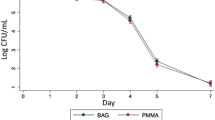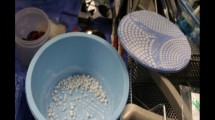Abstract
Background
In a resource poor country like ours, left-over ceftriaxone-impregnated beads produced intraoperatively for treating chronic osteomyelitis need not be wasted. The possibility of keeping them on the shelf for use for indigent patients and also in the treatment of open fractures that often present late in our environment was considered. Thus, it became necessary to evaluate the shelf life of these antibiotic beads when stored as dry or wet beads at tropical room temperature.
Methods
Dry and wet ceftriaxone–polymethylmethacrylate (PMMA) antibiotic beads produced at a ratio of 1:20 using the Alonge–Wale intraoperative antibiotic bead maker were placed in agar plates containing pure cultures of Pseudomonas aeruginosa, Staphylococcus aureus, Klebsiella species and Escherichia coli that were propagated in brain–heart infusion broth. Zones of inhibition or peribeadal lysis were measured at 6 and 12 weeks, 3, 6 and 12 months, respectively.
Results
At 12 months (from the date of production of the beads), the dry beads at tropical room temperature continued to elute significant quantity of ceftriaxone against all the microorganisms cultured in this study. In contrast, the elution from the wet beads (soaked in sterile phosphate-buffered saline) diminished remarkably after 6 weeks.
Conclusions
This study shows that ceftriaxone–PMMA beads when dry-stored for up to 12 months at tropical room temperature continue to elute inhibitory concentrations of ceftriaxone. The ceftriaxone–PMMA beads can, therefore, be available ‘off the shelf’ at least for 12 months after preparation.


Similar content being viewed by others
References
Wilson KJ, Cierny G, Adams KR, Mader JT (1988) Comparative evaluation of the diffusion of tobramycin and cefotaxime out of antibiotic-impregnated polymethylmethacrylate beads. J Orthop Res 6:279–286
Walenkamp GH, Kleijn LL, de Leeuw M (1998) Osteomyelitis treated with gentamicin–PMMA beads: 100 patients followed for 1–12 years. Acta Orthop Scand 69:518–522
Alonge TO, Ogunlade SO, Omololu AB, Fashina AN, Oluwatosin A (2002) Management of chronic osteomyelitis in a developing country using ceftriaxone–PMMA beads: an initial study. Int J Clin Pract 56:181–183
Finsterbusch A, Argaman M, Sacks T (1970) Bone and joint perfusion with antibiotics in the treatment of experimental staphylococcal infection in rabbits. J Bone Joint Surg Am 52:1424–1432
Kawanabe K, Okada Y, Matsusue Y, Iida H, Nakamura T (1998) Treatment of osteomyelitis with antibiotic-soaked porous glass ceramic. J Bone Joint Surg 80-B:527–530
Alonge TO, Fashina AN (2000) Ceftriaxone–PMMA bead: a slow release preparation? Int J Clin Pract 54:353–355
Alonge TO, Wale A (1999) Intra-operative antibiotic bead maker: point of technique. Afr J Med Med Sci 28:193–194
Stone PA, Armstrong PA, Bandyk DF, Brumberg RS, Flaherty SK, Back MR, Johnson BL, Shames ML (2006) Use of antibiotic-loaded polymethylmethacrylate beads for the treatment of extracavitary prosthetic vascular graft infections. J Vasc Surg 44:757–761
Bruce AS, Kerry RM, Norman P, Stockly I (2001) Fluconazole-impregnated beads in the management of fungal infection of prosthetic joints. J Bone Joint Surg Br 83:183–184
Seeley SK, Seeley JV, Telehowski P, Martin S, Tavakoli M, Colton SL, Larson B, Forrester P, Atkinson PJ (2004) Volume and surface area study of tobramycin-polymethylmethacrylate beads. Clin Orthop Relat Res 420:298–303
Balsamo LH, Whiddon DR, Simpson RB (2007) Does antibiotic elution from PMMA beads deteriorate after 1-year shelf storage? Clin Orthop Relat Res 462:195–199
Cunningham A, Demarest G, Rosen P, DeCosta DA (2000) Antibiotic bead production. Iowa Orthop J 20:31–35
Ostermann PA, Seligson D, Henry SL (1995) Local antibiotic therapy for severe open fractures: a review of 1085 consecutive cases. J Bone Joint Surg Br 77:93–97
Phillips H, Boothe DM, Shofer F, Davidson JS, Bennett RA (2007) In vitro elution studies of amikacin and cefazolin from polymethylmethacrylate. Vet Surg 36:272–278
Ramos JR, Howard RD, Pleasant RS, Moll HD, Blodgett DJ, Magnin G, Inzana TJ (2003) Elution of metronidazole and gentamicin from polymethylmethacrylate beads. Vet Surg 32:251–261
Alonge TO, Ogunlade SO, Fashina AN (2002) Microbial isolates in chronic osteomyelitis—a guide to management. Afr J Med Med Sci 31:167–169
Anguita-Alonso P, Giacometti A, Cirioni O, Ghiselli R, Orlando F, Saba V, Scalise G, Sevo M, Patel R, Balaban N (2007) RNAIII-inhibiting peptide-loaded polymethylmethacrylate prevents in vivo Staphylococcus aureus biofilm formation. Antimicrob Agents Chemother 51:2594–2596. [E-pub 2006; Nov 20]
Mader JT, Calhoun J, Cobos J (1997) In vitro evaluation of antibiotic diffusion from antibiotic-impregnated biodegradable beads and polymethylmethacrylate beads. Antimicrob Agents Chemother 41:415–418
McLaren AC, Nelson CL, McLaren SG, Wassell DL (2005) Phenolphthalein used to assess permeability of antibiotic-laden polymethylmethacrylate: a pilot study. Clin Orthop Relat Res 439:48–51
Ensing GT, Hendriks JG, Jongsma JE, van Horn JR, van der Mei HC, Busscher HJ (2005) The influence of ultrasound on the release of gentamicin from antibiotic-loaded acrylic beads and bone cements. J Biomed Mater Res B Appl Biomater 75:1–5
Acknowledgments
T. O. A. conceived of, participated in the design and coordination of the study, revised the manuscript and gave final approval of the version to be published. A. O. I. participated in the design of the study, prepared the beads and drafted the manuscript. T. E. N. took an active part in the preparation of the beads as well as coordinating the study. V. N. O. took part in the coordination and correction of the manuscript. N. A. F. conducted the microbiological aspect of the study. All the authors read and approved the manuscript. No funds were received in support of this study.
Conflict of interest statement
No benefits in any form have been or will be received from a commercial party related directly or indirectly to the subject of this manuscript.
Author information
Authors and Affiliations
Corresponding author
Rights and permissions
About this article
Cite this article
Alonge, T.O., Ifesanya, A.O., Okoje, V.N. et al. An evaluation of the shelf life of ceftriaxone–polymethylmethacrylate antibiotic beads. Eur J Orthop Surg Traumatol 19, 571–575 (2009). https://doi.org/10.1007/s00590-009-0471-5
Received:
Accepted:
Published:
Issue Date:
DOI: https://doi.org/10.1007/s00590-009-0471-5




